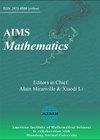一种基于地理位置数据的时空模型,利用逆图分析传染性人群
IF 1.8
3区 数学
Q1 MATHEMATICS
引用次数: 0
摘要
移动设备为我们提供了一个重要的数据来源,可以捕捉到个人的空间运动,并使我们能够得出人口随时间的一般移动模式。在本文中,我们提出了一个数学基础,使我们能够使用微分几何和图论来协调移动地理定位数据,以识别空间行为模式。我们特别关注使用计算机代数系统编程的模型,并基于时空模型,该模型允许通过空间运动模式描述传染模式。此外,我们还展示了该方法如何用于开发寻找“零号病人”的算法,或者分别用于识别最有可能具有传染性的候选人的选择。信息系统可将该方法应用于评价关于复杂人口流动的数据,例如由移动地理定位数据捕获的数据,其方式是分析地确定诸如接触事件方面的关键空间区域、关键时间段和可能易受伤害的个人。本文章由计算机程序翻译,如有差异,请以英文原文为准。
A space-time model for analyzing contagious people based on geolocation data using inverse graphs
Mobile devices provide us with an important source of data that capture spatial movements of individuals and allow us to derive general mobility patterns for a population over time. In this article, we present a mathematical foundation that allows us to harmonize mobile geolocation data using differential geometry and graph theory to identify spatial behavior patterns. In particular, we focus on models programmed using Computer Algebra Systems and based on a space-time model that allows for describing the patterns of contagion through spatial movement patterns. In addition, we show how the approach can be used to develop algorithms for finding "patient zero" or, respectively, for identifying the selection of candidates that are most likely to be contagious. The approach can be applied by information systems to evaluate data on complex population movements, such as those captured by mobile geolocation data, in a way that analytically identifies, e.g., critical spatial areas, critical temporal segments, and potentially vulnerable individuals with respect to contact events.
求助全文
通过发布文献求助,成功后即可免费获取论文全文。
去求助
来源期刊

AIMS Mathematics
Mathematics-General Mathematics
CiteScore
3.40
自引率
13.60%
发文量
769
审稿时长
90 days
期刊介绍:
AIMS Mathematics is an international Open Access journal devoted to publishing peer-reviewed, high quality, original papers in all fields of mathematics. We publish the following article types: original research articles, reviews, editorials, letters, and conference reports.
 求助内容:
求助内容: 应助结果提醒方式:
应助结果提醒方式:


